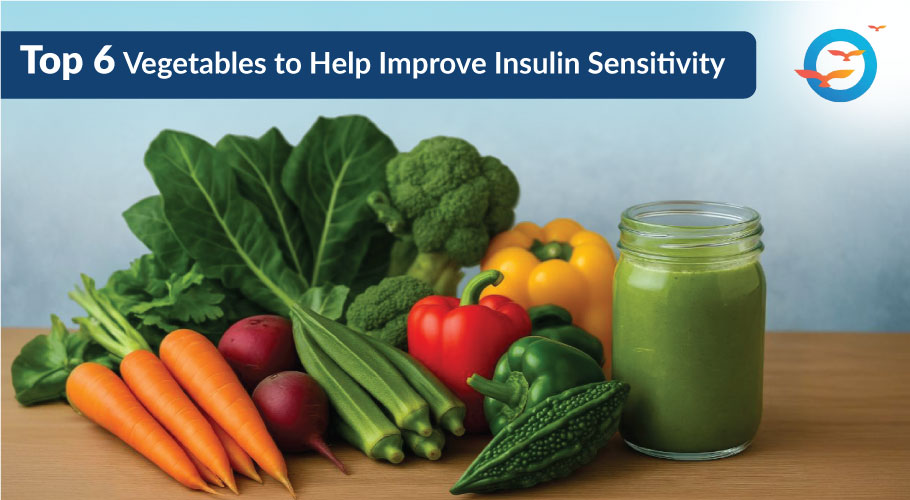Top 6 Vegetables to Help Improve Insulin Sensitivity

Top Insulin-Friendly Vegetables You Should Add to Your Plate Today
Insulin resistance is a condition where the body’s cells stop responding properly to insulin, leading to elevated blood sugar levels. Left unmanaged, it can lead to prediabetes or type 2 diabetes. While exercise, sleep, and stress management all play vital roles in improving insulin sensitivity, diet remains the most powerful tool.
The best vegetables for insulin resistance are rich in fiber, antioxidants, and bioactive compounds that help lower inflammation, boost insulin response, and support metabolic health. In this blog, we’ll explore the top vegetables that support insulin sensitivity and how to include them in your diet.
Why Are Vegetables Important for Insulin Sensitivity?
Vegetables are low in calories, packed with fiber, and rich in vitamins and minerals. Some go even further, they actively help reduce insulin resistance by lowering inflammation, improving gut health, and stabilizing blood glucose levels. These are often referred to as natural insulin vegetables or insulin-rich vegetables for their ability to naturally regulate blood sugar and insulin.
Including the right vegetables in your diet to increase insulin sensitivity can help your body respond better to insulin and reduce the risks associated with insulin resistance.
1. Leafy Greens: Best for Metabolism
Spinach, kale, fenugreek leaves (methi), and Swiss chard are some of the best veggies for insulin resistance. They’re rich in magnesium, a key mineral that plays a role in insulin action. Leafy greens are also high in antioxidants and polyphenols that fight inflammation.
Why they work: High fiber, low glycemic index, anti-inflammatory properties
How to use: In soups, smoothies, or lightly sautéed with spices
2. Broccoli and Cruciferous Vegetables
Broccoli, cauliflower, Brussels sprouts, and cabbage are known as vegetables that reduce inflammation. These cruciferous vegetables contain sulforaphane, a plant compound proven to improve insulin resistance and reduce oxidative stress (Healthline).
Why they work: Support liver detox, reduce blood sugar spikes, rich in fiber
How to use: Steam, roast, or stir-fry with garlic and turmeric
3. Bitter Gourd (Karela)
Often referred to as a natural insulin vegetable, bitter gourd has been traditionally used in Ayurvedic medicine to regulate blood sugar levels. It contains charantin and polypeptide-p, compounds known to mimic insulin.
Why it works: Boosts insulin secretion, reduces glucose absorption
How to use: Juice, stir-fried with spices, or added to soups.
4. Bell Peppers
Colourful and crunchy, bell peppers are rich in antioxidants like vitamin C and beta-carotene, which help fight oxidative stress, a key contributor to insulin resistance.
Why they work: Anti-inflammatory, low-calorie, rich in antioxidants
How to use: Roasted, in salads, or sautéed with tofu or legumes
5. Okra (Bhindi)
Okra is often overlooked, but it’s one of the best vegetables for insulin resistance. It contains mucilage, a gel-like substance that slows sugar absorption in the intestines.
Why it works: High fiber content, slows glucose absorption
How to use: Dry sauté, curry, or added to stews
6. Carrots & Beets (in moderation)
Root vegetables like carrots and beets, when eaten raw or lightly cooked, can be part of a diet to increase insulin sensitivity due to their antioxidant and anti-inflammatory benefits.
Why they work: Beta-carotene and nitrates improve metabolic flexibility
Note: Consume in moderation due to their higher natural sugar content
Before You Fill Your Plate: A Quick Word
While the vegetables listed here are generally excellent for enhancing insulin sensitivity, not all of them may suit every individual. Every body is different. Before making any dietary changes, especially if you’re managing a health condition, consult your doctor or a qualified diet expert. They’ll help you personalise your plate based on what your body truly needs.
Cooking Tips for Insulin-Supportive Vegetables
- Avoid overcooking: Overcooking can destroy antioxidants and increase the glycemic load. Steam or sauté vegetables to preserve nutrients.
- Pair with healthy fats and protein: Adding nuts, seeds, or legumes improves nutrient absorption and further slows sugar release.
- Watch out for inflammatory vegetables: Potatoes and corn may spike blood sugar and contribute to inflammation if consumed excessively.
Can Juices and Smoothies Help?
Vegetable smoothies made with low-GI ingredients like spinach, cucumber, and celery can support insulin sensitivity. Avoid high-sugar fruit juices and always include fiber-rich pulp to avoid sugar spikes.
Final Thoughts
Managing insulin resistance doesn’t require extreme diets. By simply including the best vegetables for insulin resistance in your daily meals, you can improve your body’s response to insulin and reduce the risk of type 2 diabetes.
Remember: variety, moderation, and balance are key. Choose a rainbow of vegetables, avoid inflammatory foods, and cook smartly. These small steps can make a big difference to your metabolic health.
You can read more about foods that help boost your immunity on our blog.
FAQs
What are the best vegetables to improve insulin sensitivity?
Leafy greens, broccoli, bitter gourd, bell peppers, okra, and carrots are top choices.
Can eating more vegetables help reduce insulin resistance?
Yes, especially non-starchy vegetables rich in fiber, antioxidants, and anti-inflammatory compounds.
Which leafy greens are good for insulin sensitivity?
Spinach, kale, fenugreek leaves, and Swiss chard are highly effective.
What foods naturally boost insulin sensitivity?
Vegetables, legumes, whole grains, and healthy fats improve insulin response.
How can I include more insulin-friendly vegetables in my diet?
Add them to stir-fries, salads, soups, smoothies, or as main dishes like sabzi or curry.
Is bitter gourd good for insulin resistance?
Yes, it contains compounds that mimic insulin and support sugar regulation.
Do cooking methods affect how vegetables support insulin sensitivity?
Absolutely. Steaming and light sautéing retain nutrients better than boiling or frying.
Can vegetable smoothies or juices help improve insulin sensitivity?
Yes, when made without added sugars and with fiber-rich veggies.

